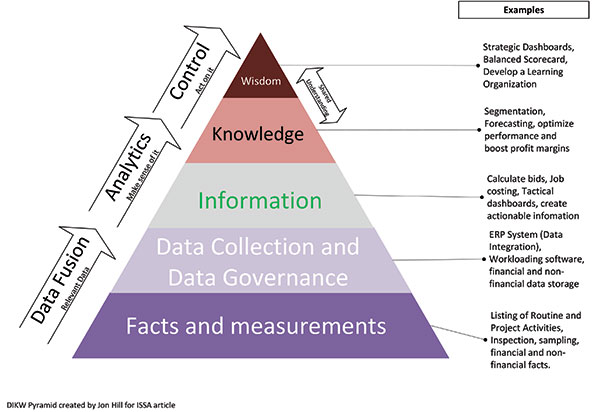Data, Information, Knowledge, and Wisdom

In today’s data-driven world, companies can excel in generating and storing vast amounts of data. Yet, the challenge lies in harnessing this abundance to derive actionable insights and informed decisions. How do we transform raw data into valuable information, knowledge, and wisdom?
In this article, we will delve into the pivotal role of structured data infrastructure in empowering management decision-making. Let’s explore practical strategies for leveraging ERP systems to elevate decision-making processes and drive productivity and profitability.
I had the privilege of being a part of an innovative change at a Richmond-based company, where we created an information revolution through a concept called Information-Based Decision-Making (IBDM). This concept revolutionized our operations and eventually led to the spin-off of Capital One in 1995. While these concepts have become more commonplace across industries, many companies still grapple with structuring a framework and training their teams to utilize information effectively. This series of articles will focus on some concepts to consider as you build decision-making concepts in your organizations.
Decision-making involves identifying a goal, getting the relevant and necessary information, and weighing the alternatives in order to make a decision. The concept sounds simple, yet many companies overlook some of the critical stages and risks that occur when making decisions.
The first step is defining the problem and clarifying the objectives that any decision aims to achieve. A standard problem-solving methodology framework like Lean’s A3 ensures alignment throughout the company. Next, basing the decision on data and evidence-based analysis helps. Data-driven analysis helps ensure that decisions are grounded in reality rather than speculation.
Data-driven methodologies encompass the progression from data to wisdom, signifying the evolution from raw information to informed action. At the base lies data, followed by information, knowledge, and, ultimately, wisdom (DIKW). Each tier represents a deeper level of understanding and value extraction from the initial data.
Enriching financial and non-financial data with our particular experiences enhances our ability to derive knowledge and insights from information, empowering better decision-making. The DIKW pyramid captures this concept, delineating the hierarchy of data utilization in an active framework. At its highest tier, knowledge and insights culminate in actionable wisdom, guiding our strategic endeavors and fostering continual learning and improvement. Another article will explore how to apply this learning throughout the organization. First, let’s define each tier of the DIKW pyramid.
Data
Data comprises raw or unorganized facts, such as sales figures, customer names, or product codes. These elements serve as the fundamental building blocks for generating meaningful information and insights. Focusing on data governance is very important in this and every other tier.
Data governance involves managing all aspects of data as an organizational asset, which includes collecting, storing, using, and overseeing data to ensure secure, efficient, and cost-effective leverage.
Information
Information is positioned next in the DIKW Pyramid. It represents refined and processed data stripped of errors (by data governance). Examples include summarized sales reports, demographic charts, and trend analyses, which enhance accessibility and usability for benchmarks, visualization (graphs), and analysis.
Knowledge
The transition from information to knowledge hinges on its relevance to the organization’s objectives. It’s about understanding how pieces of information interconnect to generate added meaning and value.
Crucially, it involves discerning how you can apply this knowledge effectively. For instance, understanding customer preferences from sales data enables tailored marketing strategies, providing a competitive edge. This deeper comprehension of implicit relationships elevates insights, propelling the importance of the information higher in the DIKW pyramid.
Wisdom
At the very top tier of the DIKW pyramid lies wisdom, achieved by answering questions like ‘why’ and ‘what’s best.’ It’s knowledge in action.
Yet, we attain true wisdom when we proactively employ this knowledge to inform strategic decisions. It’s the culmination of leveraging insights from past data to anticipate future trends, thus reaching the pinnacle of the DIKW pyramid—for instance, a seasoned CEO’s decision to pivot strategies based on their experiences.
Many professional athletes have wisdom learned from years of hard work and practice. In John McPhee’s book “A Sense of Where You Are,” he describes how Bill Bradley taught himself to train his body and mind to become a great basketball player. He developed his wisdom by learning how to practice, repeating those skills, and continuously improving—in other words, he spent many hours in focused practice. John McPhee could have been writing about Bill Gates, Meg Whitman, Jeff Bezos, Oprah Winfrey, Elon Musk, or many successful business personalities.
We can also say that if data and information are like a look back to the past, knowledge and wisdom are associated with what we do now and what we want to achieve in the future. How do we create this type of decision-making data—for example, calculating customer lifetime value (CLV) for acquiring, retaining, and winning back profitable customers?
Peter Drucker, widely regarded as the father of modern management, approached decision-making with a focus on effectiveness, innovation, and long-term sustainability. In the next issue of ISSA Today, we will dig more into this topic.



















